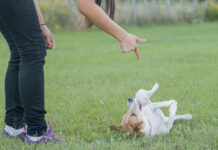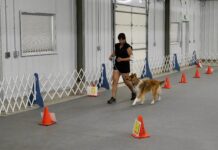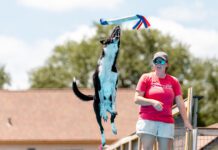The cattle dog-mix races across the turf, his claws digging into the ground, pushing hard into his next stride, building momentum, faster, faster, faster. With a final turbo blast powered by his rear legs, he pushes off the ground and vaults into the air, seemingly weightless as he stretches his neck into the sky. A sudden twist of shoulders propels his torso and hips 180 degrees as he changes direction midair and snatches the prize from the air – a simple, round plastic disc.
Photo by Jen Gregg
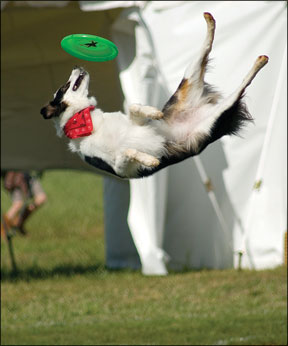
Eyes alight with the thrill of the chase and the kill (catch), he lands nimbly and races back to his handler. Can we do it again? Can we, can we? Yeah, we can.
This is the sport of disc dog. It’s been around since Frisbees became popular in the early 1970s and the players’ dogs chased the players’ errant tosses. When a bad toss resulted in a disc rolling on its side, that was fine by Fido. When a disc skimmed the ground, that was fine, too. And when the disc floated, tantalizing in the air, that was simply perfect, allowing Fido to analyze velocity and drift and match his body’s physical prowess to the job at hand. If he got a little too excited at the prospect of a toss and jumped up at his person and ricocheted off his body as the disc sailed away, how cool was that? All of these (and more) eventually made their way into disc dog training and competition.
History of Disc Dog
The first disc dog exhibition to grab the public’s attention was in 1974 in Los Angeles at a baseball game between the Dodgers and the Cincinnati Reds. Alex Stein, a 19-year-old college student from Ohio, crashed the game with his Whippet, Ashley. In the eight minutes before he was escorted from the field and arrested, Stein and Ashley Whippet wowed the crowd with 35-mph runs and breathtaking vaults and catches. Interest in the sport skyrocketed.
Since then, a multitude of official sanctioning organizations have been created to promote competition and the sport in general. Local and regional clubs sprouted everywhere and in some locales formal group classes are offered to help people and dogs prepare for competition. Some top-flight competitors even turned their hobby into livelihoods, offering exhibitions for hire for public demonstrations to draw crowds to a variety of events.
Disc Dog Competitions
As with many of the other sports we have featured in this series, not everyone who trains for a particular sport chooses to compete. This is especially true with disc dogs. Many people love the challenge of training a particular routine, but get as much enjoyment from going to the local park and playing with their dogs as some get from competing. Playing in the park, however, can entice some into the competition ring.
That’s what happened to Chris Sexton, who got his first dog (Laika, a Border Collie) in 1995. Chris had been playing “disc golf” since 1990 and had a friend whose dog loved to fetch. “This crazy Lab-mix would fetch for hours. We discovered we could wear him out faster with a disc. When we saw an ad in the paper for a local Frisbee contest, we entered him. It was a lot of fun! Then we found out about another, bigger event coming up. I entered Laika in that one, and I was hooked.”
Sexton founded a disc dog club in Fort Collins, Colorado, called the Northern Colorado Disc Dogs, which later merged with the Front Range Flyers to form Colorado Disc Dogs. Then, in 2000, he and a few friends started the UFO World Cup Series, an international competition series organized like NASCAR or World Cup Skiing, where teams accumulate points to qualify for the final “World Cup Final” championship event. So, be forewarned: like many dog sports, this one can be addictive!
There are several different events for which teams train and compete. Points are accumulated for titles as well as to qualify for larger, national events.
• Toss and fetch: This is the bread and butter of the sport and the event that most people start with. This short-distance event goes by a variety of names such as “mini distance,” “throw and catch,” and “distance/accuracy,” but the goal is the same: You have a set amount of time – as little as 60 seconds – to throw a disc as many times as you can, with your dog retrieving it before it is thrown again. The field is marked with increasingly longer distances and you are judged on the distance and the number of tosses and catches. The average distance is about 40 to 45 yards.
Dogs are scored on their ability to catch the most discs, but can earn extra points for catching the discs while completely airborne (where the dog’s body leaves the ground). Thus, if the handler is good at throwing the disc predictably longer and higher, the team has a better chance of scoring higher than teams whose throws are shorter and lower.
• Freestyle: This event is where some of the most amazing acrobatics happen. Jumping off handler’s bodies, vaulting and twisting high in the air, and racing around and/or through the handler’s legs are common pieces of increasingly elaborate and complex routines. Each routine is between 30 seconds and 3 minutes long and individually choreographed by the handler. Each piece of the routine (e.g., leg weaving) is trained individually and then linked together into the final routine performed to music selected by the handler.
Teams are judged for creativity, athleticism, difficulty, showmanship, etc. As the sport has matured, routines have become more and more spectacular and have become the most popular event at public exhibitions.
• Long distance: This event is rarer than the two above. It pits teams against each other in an elimination-style event, with the winning teams successfully throwing the longest distances. This event has separate classes for women and for men. Women in this long-distance event typically throw 50 to 60 yards, although some have thrown in excess of 65 yards. For long-distance men, 70 to 80 yards is considered competitive, although throws of 90-plus yards have been recorded.
Some clubs and sanctioning organizations promote a variety of other events in addition to the ones listed above. As with many of the dog sports, dogs should be in good physical condition and be at least 12 to 18 months of age before competing.
Disc Training
Not all dogs hit the ground running, chasing, and leaping after plastic discs. If yours does, you are one of the lucky ones. Most dogs – and handlers – still need training to perfect the individual pieces of a routine, or to catch a disc in midair instead of waiting for it to hit the ground. Most people learn and train on their own or with local clubs since formal classes are quite rare.
“I learned primarily on my own,” remembers Chris Sexton. “There wasn’t very much in the way of videos or books, so the way that I learned new throws and tricks was to go to contests and watch, and then go home and try to replicate what I saw.
“Today, with the Internet, people can watch videos, read training articles, and ask anyone any question. This access to information means that people can get up to speed even if they are isolated. I saw this in action in 2009 on a trip to China. Chinese disc dog people have been watching people in Japan, Europe, and the U.S. on the Internet for years. They copy the moves and read the articles, so the level of talent there is respectable.
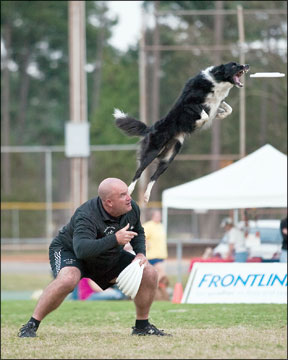
“One other aspect that has helped the sport a lot is the proliferation of clubs. The disc dog clubs started in the mid 80s, but took off really big in the mid to late 90s. Having a group of people to practice with and participate with is a really big help. I think the clubs are the source of most ingenuity in the sport, and bring the most people in.”
Most training starts with straight tosses to the dog at very short distances. Once the dog catches those with a high degree of success, distances are increased and the height of the toss is increased. Eventually, discs are tossed just over the dog’s head and the dog leaps a bit to catch it. The handler has to work hard to ensure that the timing of the disc toss is well timed with his dog’s speed.
The websites of disc dog sanctioning organizations and clubs often provide training information and/or links to other sites; see the next page for contact information and Web addresses.
Disc Dog Team Attributes
Owners are often motivated by seeing their active dog have a fun outlet for his energy and talents. Although some people search for dogs with the energy for the sport, some gravitate to the sport because they ended up with a dog with too much energy to be expended by walks around the block.
Dave Rosell, a competitor from Huntington Beach, California, remembers when he got his first dog, Hook. “I wanted to get a dog to take on walks, go hiking with, and such. What I ended up with was a high-drive Australian Shepherd. He was full of energy and never seemed to tire even after having him fetch tennis balls or play tug for hours -well, it seemed like hours! So I started looking on the Internet for training and different activities I could do with him. I found Dog Services Unlimited, which offered not only obedience training, but also basic agility, flyball, and disc dog. I took all the classes.”
Energetic dogs who live to chase and retrieve love this sport. Sexton, who competes with two herding dogs, says a variety of dogs do well in disc dog events. “Herding breeds and retrievers are usually naturals. Their instinctive behaviors lend themselves very easily to disc play. Most smart dogs will enjoy the game and the challenge and interaction of the training as well. Border Collies, Aussies, Labs, Poodles, shepherds, some terriers, all do well. But, if there is one group that stands out, it would have to be the mutt! These dogs often have several aspects of those desirable qualities. Many mix-breeds excel in the sport.”
People who love this sport tend to love competition and share a love of seeing their dogs thrill at being in action and learn new physical tricks. Some competitors incorporate very physically demanding handler maneuvers, while others do very little, leaving the acrobatics to their dogs.
This sport is physically demanding on the dogs, but Sexton believes that, with care, you can safeguard your dog from injury. “It really depends on the dog and the handler, but in general, it’s no harder on dogs than playing outside and running around like a normal dog. The method to keep it safe is to start low and simple and build up to the more difficult tricks over time. This allows the dog to gradually learn the harder tricks and the body control required, which will make the tricks safer.
“Thankfully, injuries are not common in this sport! But you do see occasional tweaks and twists to legs that might cause a dog to come up lame for a bit. These are usually mild and rare. Another injury is in the form of cumulative damage from excessive height. In addition to normal aging-dog symptoms, I have seen a few dogs that had unusually stiff or arthritic joints when they were older. This can be partly genetic, but I think that the style of play can also be a factor. Excessive height in jumping is not only unnecessary, but even if the dog seems to land clean, he might accumulate long-term damage that could make for a less-pleasant retirement. Like many things, a little common sense goes a long way.”
Steven Donahue is a professional photographer who has taken photos for Purina Incredible Dog Challenge events for a number of years. When people see his photos of disc dog aerial superstars twisting through the air, or even fully upside down in mid-catch, they frequently comment, “Wow! I’ll bet those dogs get hurt a lot!” He replies, “I’ve been following the disc dog sport closely for about five years. I have seen hundreds of dogs who have been in the sport for years. During that time, I only know of a few minor injuries, and one career- (not life-) ending injury.
“With all that said, I would strongly discourage novice handlers from attempting advanced moves. First and foremost, know your breed, know your dog, and perform safe maneuvers with those limitations in mind. Secondly, know how to place/throw the disc for a safe flip or small vault before you ever even think about attempting it with a dog. Dogs with high drive will put themselves in danger attempting to catch poorly thrown discs.
“A personal example on knowing the limitations of your breed/dog. I have a Flat-Coated Retriever who is insane for the Frisbee. He would try to do this kind of stuff if I let him. However, he is awkward in the air compared to these Border Collies and Aussies. He doesn’t land safely on all fours if I do anything other than simple toss-and-fetch throws for him. So, that’s all we do.”
Easy to Start, Difficult to Perfect
Dave Rosell of Huntington Beach, California, trains and competes in three sports with two of his three dogs. When put on the spot and asked to compare his three chosen sports — agility, flyball, and disc dog — he does a good job of highlighting the attraction of each. But he has a soft spot for disc dog.
“Disc dog is great because you can start competing once you are good enough to throw a disc and your dog can catch it. But it also takes a tremendous amount of work and skill to be good enough to compete at the pro freestyle level. You probably have to spend as much time without your dog to learn your throws and routines as you do with your dog.
“I love the excitement that my dogs have when we play discs, but also the camaraderie that you have with the other disc doggers out there. They’re always there to congratulate you, give you advice, or help in any way. Another neat thing about disc dogs is you only need a couple of discs for your dogs to play, whereas with the other sports you usually have to have all kinds of equipment laid out before you can start practicing,
“Disc dog clubs help a lot. If you join a club, you get a lot of help and camaraderie i in addition to discounts on entry fees! Disc Dogs in southern California puts on most of the competition events in that area as well as joint ventures with other clubs. Its website has some training aids, a calendar of events, results of competitions, links, and information about the sport. Periodically it puts on ‘play days’ where the members and prospective members get together and the more experienced members help with some throws, with routines, and maybe even have a mini competition. But the big thing is that the people in the club are just a great bunch of people. We are a bunch of friends who get together with one thing in common: we are all disc dog crazy.”
Disc Dog Activity Expenses
The beauty of this sport is that all you need is your dog and a plastic disc and some space to throw it. Many of the websites listed in Resources will direct you to find the best discs (the hardest ones are not good on your dog’s mouth) as well as training materials. Entry fees and travel will be your biggest expenses, and these are still modest compared to many of the other dog sports.
If you can find a class, costs are usually modest – from $35 for classes and seminars to $80 per hour for private lessons. Competition fees run anywhere from completely free to $30 per class. Gas and lodging might be your next biggest expense, but the popularity of disc dogs has made competitions and exhibitions more plentiful than ever so you might not have to travel too far.
How to Get Started
Even if you don’t want to compete, joining a local club will be the fastest way to get up to speed. Club members are typically very helpful to newcomers and have a lot of experience to share. You and your dog can gain competition ring experience by first participating in public demonstrations with the club. Then, just take your dog and disc, smile, and toss!
Terry Long, CPDT, is a writer, agility instructor, and behavior counselor in Long Beach, CA. She lives with four dogs and a cat and is addicted to agility and animal behavior.



